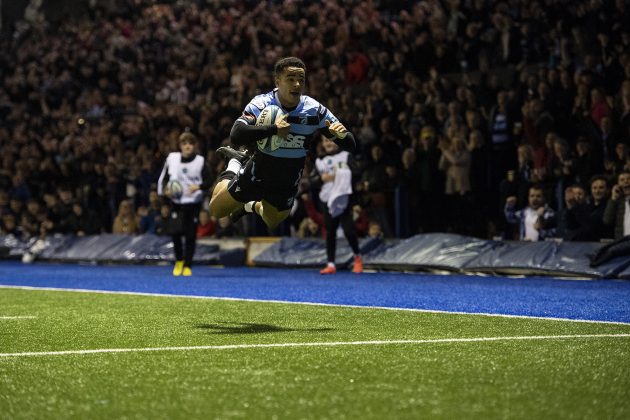The new season of The Intercept continues with the Cardiff winger's game-breaking score in the URC
The Intercept: Theo Cabango’s Try Against Stormers
This month we welcome back the ‘Secret Analyst’ to run the rule over Theo Cabango‘s try as Cardiff beat the Stormers in the United Rugby Championship.
Cabango has made a name for himself already with his elite speed. Against the Stormers, he used it to great effect as Cardiff kicked twice to exploit the Stormers’ back-field defence.
⏱️ Half-time in the #URC:
??????? Cardiff 14-14 Stormers ?? #CARvSTO
? Follow the action live. ? https://t.co/xn2GTkGkoZpic.twitter.com/xfKQPpwWDt
— Planet Rugby (@PlanetRugby) October 22, 2022
The clip above shows the finishing flourish that led to Cabango touching down. But the try was actually made with a kick just a few moments previously from a defensive ruck.
This is a great attacking exit kick from Cardiff which led to that fantastic Theo Cabango try against the Stormers. Cardiff walking the tight rope of being aggressive while also gaining territory. pic.twitter.com/b49UaNYQpO
— Sam Larner (@SamLStandsUp) November 2, 2022
We spoke to the Secret Analyst to understand why that first kick was so important and how it eventually led to the try on the opposite side of the pitch.
Theo Cabango’s Try Against Stormers
“We see the strength of Cardiff’s contestable kicking game at the origin of this try. Some teams may have opted to kick their exit long to get as far out of their 22 as possible. However, with Stormers’ counter-attack threat, led by Clayton Blommetjies, the clear aim here is to go contestable with their exit. With the advantage of having a big winger in Jason Harries also on their side, they manage to get the ball tapped back.”
That is a decision that all teams and coaching set-ups need to make. A contestable kick will naturally be shorter than a non-contestable one. That’s not a problem if you can win the ball back, but if you can’t, you are giving up valuable territory. Against the Stormers, and their array of counter-attacking riches, the decision was made for Cardiff to be contestable with their kicks.
“During transition is often where the back-field is compromised. Manie Libbok is slow to go to his post on the right-hand side of the back-field because of how quick the transition happens, and Rhys Priestland shows great awareness to notice the artificial grass in the back-field. Out of nowhere and out of sight of the TV cameras, comes flying Theo Cabango to score a crucial try.”
That first kick from Tomos Williams pulls the Stormers defenders to the far side of the pitch. The Stormers are expecting to have possession of the ball, even contestable kicks are usually won by the receiving team. When they lose the ball, suddenly they are back in transition. They need to drop deep to cover the new threats that have emerged now that Cardiff have the ball back. Libbok has pushed upfield to begin the anticipated Stormers’ attack and is now slow to track back and cover the space in behind.
“Rhys Priestland, alongside his attack coach, got heaps of praise in the press post-match for the accuracy of their game plan and kicking game. This game plan, which saw Cardiff kick 34 times, in contrast to Stormers’ 20 kicks, ultimately brought an end to Stormers’ 15-game unbeaten streak.”
Kicking is often derided, but it can lead to exciting play like this. The two Cardiff kicks separated the, usually strong, Stormers’ defence and created the small amount of space needed for Cabango to run clear.
There are similarities to two tries that Finn Russell was at the heart of. This first one was against Samoa at the 2019 Rugby World Cup.
A Finn Russell one-two kick combo?
Coming right up!#RWC2019 | @Scotlandteam pic.twitter.com/iogCAGBOqB
— Rugby World Cup (@rugbyworldcup) February 7, 2022
The gap between the two kicks is longer but you can see how one contestable kick pulls the defence one way and the second exploits the space they have let behind.
The second try is more famous; it is the penalty try scored by Scotland in the 2022 Calcutta Cup where Russell kicked two consecutive cross-field kicks that stretched England to breaking point.
A closer look at the Penalty try #SCOvENG Did Scotland find a system error in England's Defence with Russell's double cross-field kick. Thoughts on Defence Shape? Easy fix for England but too late! #SixNations2022 #SixNations #rugbyanalysis pic.twitter.com/Ai5d71s8gx
— Brett Igoe (@brettruganalyst) February 6, 2022
One element of the Cardiff try that we haven’t yet discussed is Cabango’s pace. We hear often that you can’t defend against pace. It might be true that you can’t defend someone with pace who has space to work in, but our Secret Analyst explains how teams will try to reduce the impact a pacey player has.
“As an analyst, it can be tough to stop pure speed. You want to limit their space for one, which you can do by getting your back-line to defend as high possible to cut off the supply chain. This can be risky as it may allow for floating passes over the top of your last defender, which can put the speedy winger in space if the pass is not cut off.
“The other way is to limit their time with the ball on the grass. This is shown in this try, where the contestable kicking game becomes so effective. More time in the air, ultimately limits the time they have with the ball in open space, where speed becomes dangerous.”
It was a fantastic finish by Cabango created by some great vision by Priestland and smart pre-match analysis by the entire Cardiff team.
Download the digital edition of Rugby World straight to your tablet or subscribe to the print edition to get the magazine delivered to your door.
Follow Rugby World on Facebook, Instagram and Twitter.





